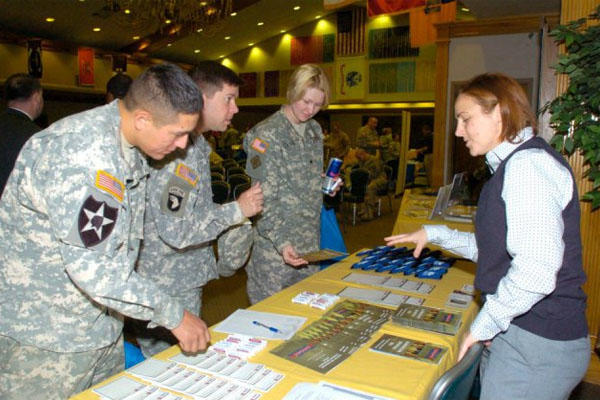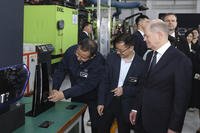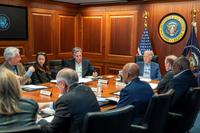Separating troops and veterans are finding it easier to get jobs but the demand on the revamped transition programs of the military will only increase as the services downsize.
The vast majority of active-duty troops going into civilian life gave a thumbs up to the Transition Assistance Programs (TAP) but "we must continue to work with federal partners and the private sector to gather lessons learned, improve the curriculum, instill a culture of planning for post-military life and develop pipelines into the national workforce," said Susan Kelly, director of the Defense Department's Transition to Veterans Program Office.
She told the House Armed Services Personnel Subcommittee last month that a recent troop survey showed more than 80 percent agreed they "gained valuable information and skills to plan their transition" from the programs and "that the training enhanced their confidence in their transition."
Kelly said the Pentagon doesn't have a solid figure on how much the services spend on TAP to provide job assistance and separation counseling services for troops and their families but it was "in the neighborhood of $100 million."
Others testifying at the Oct. 28 hearing acknowledged that transition efforts had improved markedly since the programs were overhauled in 2013 but pointed to continuing problems in connecting with those "pipelines into the national workplace," Kelly outlined.
Some of the concerns involved coordination with the many business groups, unions and non-profits who want to help; others involved getting the troops themselves motivated to take advantage of what's available.
Rep. Joe Heck, R-Nev., the subcommittee's chairman, noted that more than 165,000 service members separate each year and that the number will only increase as the Army cuts 40,000 troops and the Marine Corps sheds 2,000 troops by 2018. Heck's bottom line was "whether recent changes have produced the desired results" in the programs.
Rep. Susan Davis, the panel's ranking Democrat, said she was encouraged that TAP had expanded from one mandatory class to a variety of programs "but there is still much work to be done."
Finding the time to take advantage of the programs was a major problem, said Scott Mann, an advisor to the non-profit American Dream U, which seeks to give troops "access to resources they need to find their dream job or to start a business of their own."
The operations tempo of many active-duty troops "does not leave a lot of time to even remotely contemplate transition," said Mann, a 22-year veteran of Army Special Operations. "This problem is probably going to get worse before it gets better," he said
Then there's the transition into the community from the military's transition programs that is the focus of the nonprofit called Zero8hundred, which seeks to match up sailors and Marines in the San Diego area with jobs and business opportunities.
Sean Mahoney, executive director of the group, said he was continually finding service members among the 20,000 separating annually in the San Diego area who were often unaware of the opportunities and services available.
"Lots of times they're frustrated that the service members aren't coming to them," he said of the groups willing to help. The troops "will be engaged and then they'll drop off," he said.
The numbers show that the job market is improving for vets and for separating troops. The Bureau of Labor Statistics reported last week that the unemployment rate in October was essentially unchanged at 5 percent.
The overall unemployment rate for veterans fell to a record low 3.9 percent in October, down from 4.3 percent in September and from 6.9 percent two years ago. For Iraq and Afghanistan-era veterans, the unemployment rate was 4.6 percent, the lowest mark since the bureau began tracking that population in 2008.
However, former Federal Reserve Chairman Ben Bernanke said that transitioning troops were still coming to a dynamically changing job market at a distinct disadvantage.
Last month at a Brookings Institution event, he called out the military for not doing more to prepare its men and women to succeed in a market economy.
"If you go into the military at age 18 -- versus an identical person who stays in the private sector and takes a private sector job -- 10 years later, if you leave the military, your skills and wages are probably not going to be as quite as high on average as the private-sector person," Bernanke said.
Any number of factors can be cited as contributing to the declining vets' jobless rate -- the improving TAP programs, tax credits for businesses hiring vets, the "Joining Forces" initiative of First Lady Michelle Obama and Dr. Jill Biden, the wife of Vice President Joe Biden, and major corporations simply coming to the realization that vets and separating troops provide an immense talent pool.
A business coalition called the 100,000 Jobs Mission, co-founded by JPMorgan Chase and 10 other corporations to hire vets, announced last week that it was changing its name to the Veterans Jobs Mission because its success had outgrown the old name.
The group said it had already hired 300,000 vets since starting in 2011 and was now setting its goal at hiring one million vets.
Acting Undersecretary of Defense for Personnel and Readiness Brad Carson said in a statement that the group's hiring successes showed "the private sector has recognized the wealth of values and skills our brave men and women have brought to their organizations and, through commitments like these, they are able to continue to tap into this talent."
At the subcommittee hearing, Army and Marine generals said they had a problem accommodating all the businesses, foundations and nonprofits seeking to counsel separating troops on job and business opportunities.
Maj. Gen. Burke Whitman, director of the Marine and Family Programs Division, said "we do have to balance" which organizations are allowed on base. The Marines "let each installation manage it" and "try to do it in a way that doesn't give preferential treatment," he said.
Brig. Gen. James Iacocca, the Army's adjutant general, said the Army similarly allows base commanders to decide on access for organizations. "We stress to our soldiers to go to transition early and often," he said. "It makes the program easier to digest."
On bases, it can often come down to a problem of coordinating with groups in the surrounding community, including businesses, local schools and increasingly unions, seeking access to separating troops, said Mark Brown, director of Human Resources at Joint Base Lewis-McChord in Washington state.
"We're hoping to build out more small business and career technical tracks," Brown said in a recent interview. He cited the training programs offered by Pacific Gas and Electric, Starbucks, Microsoft Corp. and of the 300,000-member United Association of Plumbers, Fitters, Welders and Service Technicians.
The union has begun a training program at the installation at cost per student of $20,000 paid for with union funds and then seeks to place the trainee with a union shop, he said.
"Usually, the partner reaches out to us," Brown said. "We don't really have to solicit."
He added, "What we need to do is collaborate better instead of continuing to build new organizations. Literally every day, I learn about a new organization that's working in this space that I didn't know about the day before."
--Richard Sisk can be reached at Richard.Sisk@military.com.



























